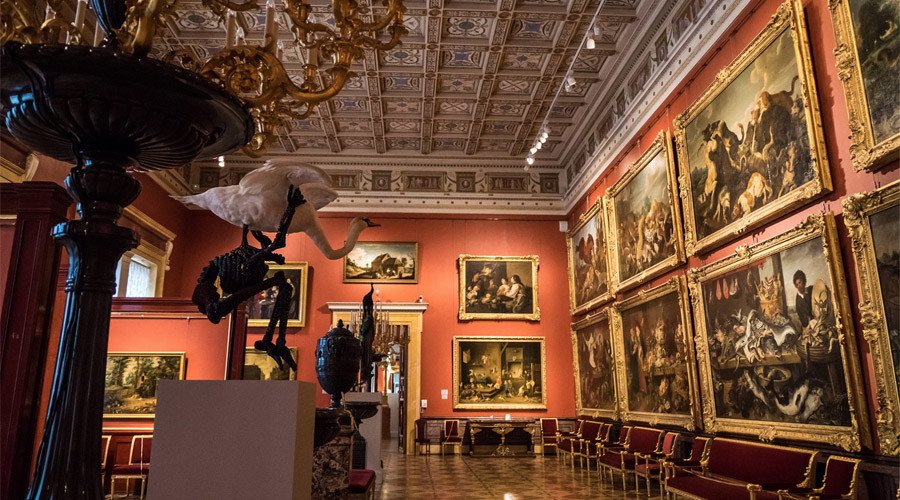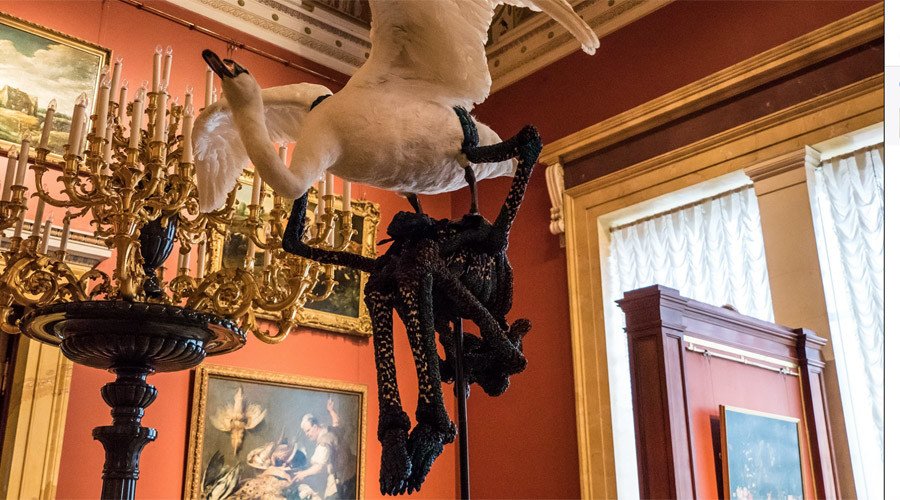Exhibition of stuffed roadkill next to Old Masters at the Hermitage provokes outrage (PHOTOS)

A deliberately provocative Jan Fabre exhibition of stuffed animals placed in grotesque poses next to some of the world’s most famous paintings has provoked outrage from traditionalists and animal rights activists. The Hermitage says it has been misunderstood.
In the preview of the show, the curators explained that Jan Fabre, the Belgian installation artist, sculptor and playwright “uses his works to speculate in a loud and tangible manner about life and death, physical and social transformations, as well as about the cruel and intelligent imagination which is present in both animals and humans.”

“Peter Paul Rubens and Jacob Jordaens are important inspirations, and the visitors will (or won’t) see it for themselves. For the exhibition period, Fabre’s works will make part of the museum’s permanent exposition and enter in a dialogue with the absolute international masterpieces,” announced the St. Petersburg museum, which, alongside the Louvre, has one of the two most important collections of 17th century Flemish art.
But when the show opened late last month, many visitors were proved unprepared for the reality behind the high-minded explanatory notes. Stuffed dogs in party hats hung from ribbons on the ceiling, a swan was seen being grabbed by a pair of sculpted demonic limbs, a crucified kitten, and three-dimension owls sat in front of respectable court paintings.

The Russian-language hashtag #shameontheHermitage spread like wildfire through Instagram, Twitter and other social media.
“While the whole of Russia is trying to fight against animal abuse, the Hermitage spits in our faces,” said LiS, a homeless animal shelter from Samara, which echoed the sentiments of several other animal rights groups, which also made a reference to several high-profile cases of cruelty to street animals in recent weeks.
“Europe is in a lengthy period of moral degradation, but why allow this here in Russia?” read a post from Sergey Karsakov, a photographer.
“I can understand that Fabre could well be mentally ill. But what was the Hermitage thinking? I am aghast at what this world has become,” said actress Olesya Grinchak.
Vitaly Milonov, a St. Petersburg politician known for his campaign against gay rights, and other “liberal Western values,” has already petitioned to have the exhibition shut down ahead of its planned date next April, as have several other prominent public figures.
But the director of the Hermitage museum, Mikhail Piotrovsky, insisted that the exhibition indeed intended to get a rise out of people, but that its detractors have entirely misunderstood the message of 200-piece display.
“The cry for animal protection is indeed the right one, and we woke people up and got them to discuss the topic. Jan Fabre tells us that people who say that they love animals throw them out, and then they die under the wheels of passing cars,” said the long-serving head of the museum, noting that the animals used by the Belgian artist were all roadkill.
“This exposes the hypocrisy in people’s attitudes towards animals,” said Dmitry Ozerkov, who curates the modern art collection at the Hermitage and commissioned the display, which was realized on a less ambitious scale in the Louvre in 2008. “We protect cats and dogs, but eat meat. We say that real art is oil paintings, but forego to mention that paintbrushes are also made of animal fur.”
Despite public appeals and online petitions, the Ministry of Culture has – so far – taken the side of the Hermitage in the debate, saying that the state-funded institution, located in the former Winter Palace where the Tsars resided, is “independent and free to choose its own artistic direction,” and “does not need to receive approval from us to stage the show.”













